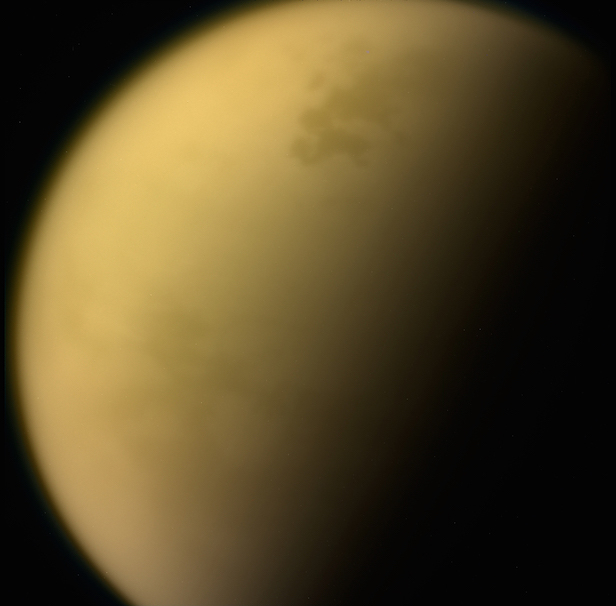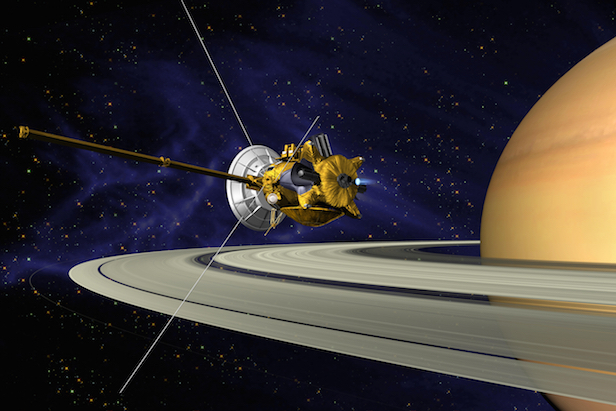Cassini uncovers poisonous clouds on Saturn’s moon Titan
Researchers with NASA’s spacecraft have found evidence of a toxic hybrid ice in a wispy cloud high above the south pole of the large moon

This view of Saturn’s largest moon, Titan, is among the last images the Cassini spacecraft sent to Earth before it plunged into the giant planet’s atmosphere. Image credit: NASA/JPL-Caltech/Space Science Institute
Researchers with NASA’s Cassini mission have found evidence of a toxic hybrid ice in a wispy cloud high above the south pole of Saturn’s largest moon, Titan.
The finding is a new demonstration of the complex chemistry occurring in Titan’s atmosphere – in this case, cloud formation in the giant moon’s stratosphere – and part of a collection of processes that ultimately helps deliver a smorgasbord of organic molecules to Titan’s surface.
Invisible to the human eye, the cloud was detected at infrared wavelengths by the Composite Infrared Spectrometer (CIRS) on the Cassini spacecraft. Located at an altitude of about 160 to 210 kilometres (100 to 130 miles), the cloud is far above the methane rain clouds of Titan’s troposphere, or lowest region of the atmosphere. The new cloud covers a large area near the south pole, from about 75 to 85 degrees south latitude.
Laboratory experiments were used to find a chemical mixture that matched the cloud’s spectral signature – the chemical fingerprint measured by the CIRS instrument. The experiments determined that the exotic ice in the cloud is a combination of the simple organic molecule hydrogen cyanide together with the large ring-shaped chemical benzene. The two chemicals appear to have condensed at the same time to form ice particles, rather than one being layered on top of the other.
“This cloud represents a new chemical formula of ice in Titan’s atmosphere,” says Carrie Anderson of NASA’s Goddard Space Flight Center in Greenbelt, Maryland, a CIRS co-investigator. “What’s interesting is that this noxious ice is made of two molecules that condensed together out of a rich mixture of gases at the south pole.”
Previously, CIRS data helped identify hydrogen cyanide ice in clouds over Titan’s south pole, as well as other toxic chemicals in the moon’s stratosphere.
In Titan’s stratosphere, a global circulation pattern sends a current of warm gases from the hemisphere where it’s summer to the winter pole. This circulation reverses direction when the seasons change, leading to a buildup of clouds at whichever pole is experiencing winter. Shortly after its arrival at Saturn, Cassini found evidence of this phenomenon at Titan’s north pole. Later, near the end of the spacecraft’s 13 years in the Saturn system, a similar cloud buildup was spotted at the south pole.
The simple way to think about the cloud structure is that different types of gas will condense into ice clouds at different altitudes, almost like layers in a parfait dessert. Exactly which cloud condenses where depends on how much vapor is present and on the temperatures, which become colder and colder at lower altitudes in the stratosphere. The reality is more complicated, however, because each type of cloud forms over a range of altitudes, so it’s possible for some ices to condense simultaneously, or co-condense.
Anderson and colleagues use CIRS to sort through the complex set of infrared fingerprints from many molecules in Titan’s atmosphere. The instrument separates infrared light into its component colors, like raindrops creating a rainbow, and measures the strengths of the signal at the different wavelengths.
“CIRS acts as a remote-sensing thermometer and as a chemical probe, picking out the heat radiation emitted by individual gases in an atmosphere,” says F. Michael Flasar, the CIRS principal investigator at Goddard. “And the instrument does it all remotely, while passing by a planet or moon.”
The new cloud, which the researchers call the high-altitude south polar cloud, has a distinctive and very strong chemical signature that showed up in three sets of Titan observations taken from July to November 2015. Because Titan’s seasons last seven Earth years, it was late fall at the south pole the whole time.
The spectral signatures of the ices did not match those of any individual chemical, so the team began laboratory experiments to simultaneously condense mixtures of gases. Using an ice chamber that simulates conditions in Titan’s stratosphere, they tested pairs of chemicals that had infrared fingerprints in the right part of the spectrum.
At first, they let one gas condense before the other. But the best result was achieved by introducing both hydrogen cyanide and benzene into the chamber and allowing them to condense at the same time. By itself, benzene doesn’t have a distinctive far-infrared fingerprint. When it was allowed to co-condense with hydrogen cyanide, however, the far-infrared fingerprint of the co-condensed ice was a close match for the CIRS observations.
Additional studies will be needed to determine the structure of the co-condensed ice particles. The researchers expect them to be lumpy and disorderly, rather than well-defined crystals.
Anderson and colleagues previously found a similar example of co-condensed ice in CIRS data from 2005. Those observations were made near the north pole, about two years after the winter solstice in Titan’s northern hemisphere. That cloud formed at a much lower altitude, below 150 kilometres (93 miles), and had a different chemical composition: hydrogen cyanide and cyanoacetylene, one of the more complex organic molecules found in Titan’s atmosphere.
Anderson attributes the differences in the two clouds to seasonal variations at the north and south poles. The northern cloud was spotted about two years after the northern winter solstice, but the southern cloud was spotted about two years before the southern winter solstice. It’s possible that the mixtures of gases were slightly different in the two cases or that temperatures had warmed up a bit by the time the north polar cloud was spotted, or both.
“One of the advantages of Cassini was that we were able to flyby Titan again and again over the course of the thirteen-year mission to see changes over time,” says Anderson. “This is a big part of the value of a long-term mission.”
The Cassini spacecraft ended its Saturn mission on 15 September 2017.
Keep up to date with the latest reviews in All About Space – available every month for just £4.99. Alternatively you can subscribe here for a fraction of the price!





